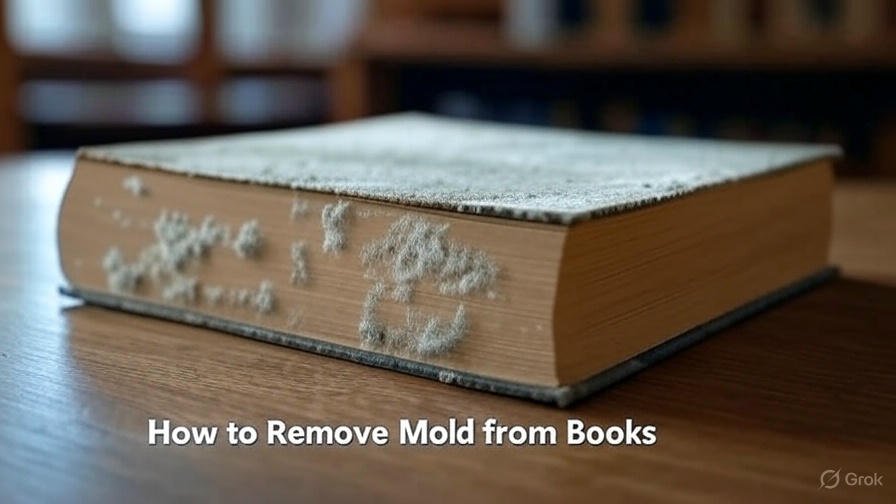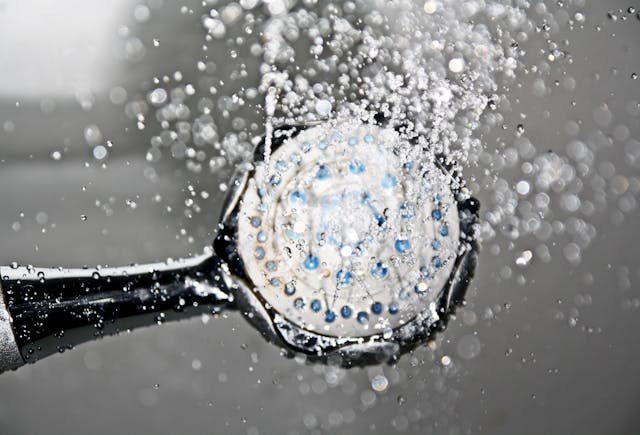Books hold not only stories and knowledge but also sentimental value, making it disheartening to discover ugly patches of mold invading your beloved collection. Mold on books not only damages the pages and covers but can also pose potential health risks, as mold spores can trigger allergies and respiratory issues.
If you’ve noticed mold creeping onto your books, don’t toss them away just yet. With the right tools and techniques, you can rescue your books and preserve them for years to come. This comprehensive guide will teach you the best way to remove mold from books safely and effectively, while also offering tips on prevention and when to seek professional help. Whether you’re dealing with a rare antique book or a treasured family photo album, you’ll find everything you need here.

What Causes Mold on Books?
Mold thrives in environments where moisture and organic matter coexist. Unfortunately, books—with their paper pages and organic binding materials like leather or glue—are particularly vulnerable when exposed to damp conditions.
Here are the main causes of mold on books:
- High Humidity Levels
Mold needs moisture to grow, and high humidity (above 65%) creates the perfect environment for mold spores to thrive. - Water Damage
Books exposed to leaks, spills, or flooding can retain moisture, allowing mold growth to take hold. - Poor Ventilation
Storing books in areas with little to no airflow, such as basements, attics, or closed cabinets, can trap moisture and foster mold growth. - Organic Binding Materials
Components like paper, leather, and glue provide organic nutrients that support mold spores.
Understanding these causes is key to addressing current mold problems and preventing future infestations.
Signs of Mold on Books
Mold on books can be tricky to identify in its early stages, but catching it early is critical for effective treatment. Here are some common signs to look for:
- Musty Odor
A stale, earthy smell is often one of the first signs of mold growth. - Discolored Patches
Mold can appear as small spots or larger patches in colors like black, white, green, or yellow. - Stained or Warped Pages
Pages may show signs of water damage, discoloration, or waviness, indicating trapped moisture. - Textural Changes
Mold growth might leave a powdery, fuzzy, or slimy residue on book covers or pages. - Deterioration of Materials
Advanced mold infestation can cause the paper to crumble or bindings to weaken.
Inspecting your books regularly can help you catch mold early and preserve their condition.
Tools and Materials Needed for Mold Removal
To remove mold from books safely, it’s important to use the proper tools and materials. Here’s what you’ll need:
- Protective Gear
- N95 mask or respirator (to avoid inhaling mold spores)
- Gloves (preferably nitrile or latex)
- Tools for Cleaning
- Soft brush (like a paintbrush or makeup brush)
- Microfiber cloths
- Cotton swabs
- Cleaning Supplies
- Rubbing alcohol (70% isopropyl) or denatured alcohol
- HEPA vacuum (with a soft-bristle attachment)
- Baking soda (for odor removal)
- Drying and Storage Supplies
- Absorbent paper towels
- Silica gel packets or desiccants
- Plastic containers with lids (for temporary storage)
Gathering these items will make the cleaning process more efficient and help protect you from exposure to harmful mold spores.
Step-by-Step Guide to Remove Mold from Books Safely
Follow these steps to clean mold from books while minimizing damage to print and materials.
Step 1: Prioritize Safety
Mold spores can cause adverse reactions if inhaled or touched. Always wear gloves and a mask while working with contaminated books. Perform the cleaning in a well-ventilated area or outdoors to prevent mold from spreading indoors.
Step 2: Isolate the Affected Books
Separate moldy books from the rest of your collection immediately to prevent cross-contamination. Store them in sealed plastic containers until you’re ready to clean them.
Step 3: Dry the Book
Mold will not grow without moisture, so start by drying the book to halt its spread:
- Place the book in a dry, well-ventilated area.
- Use a fan or dehumidifier to speed up the drying process.
- Insert paper towels between pages to absorb moisture (replace them frequently).
Avoid exposing the book to direct sunlight, as this can cause fading or warping.
Step 4: Brush Away Loose Mold
Once the book is completely dry, use a soft brush to gently remove loose mold spores. Hold the book upright and tap or shake it lightly over a trash bag to dislodge spores. Be gentle to avoid damaging fragile pages.
Step 5: Clean Moldy Spots
For stubborn spots, try one of these methods:
- Rubbing Alcohol Solution
Dampen a cotton swab or microfiber cloth with rubbing alcohol and carefully dab the moldy area. Avoid soaking the paper or applying too much pressure. - Vacuuming
Use a vacuum with a HEPA filter and a soft-bristle attachment to suction off mold spores. Avoid vacuuming delicate or antique books directly.
Always test cleaning methods on an inconspicuous area first to ensure they don’t damage the paper or binding.
Step 6: Deodorize the Book
Sprinkle a light layer of baking soda inside the book and seal it in a plastic container for several days. This can help absorb odors caused by mold. Remove any remaining powder with a soft brush.
Step 7: Inspect and Repeat
Examine the book carefully for any remaining mold. Repeat Steps 4-6 if necessary. Ensure the book is completely dry before reintegrating it into your collection.
Professional Mold Removal Options
For valuable or severely mold-damaged books, consider seeking professional assistance. Many conservators and book-restoration specialists offer services such as:
- Freeze Drying
A technique that eliminates mold while preserving delicate pages. - Chemical Treatments
Professionals can use advanced cleaning agents to remove mold without harming antique papers.
Enlisting professional help is especially advisable for rare or sentimental books where DIY methods may pose a risk.
Tips for Preventing Mold on Books
Once your books are mold-free, take these preventive measures to ensure they stay that way:
- Control Humidity
Keep your library at a humidity level of 30%-50%. Use a dehumidifier if necessary. - Improve Airflow
Ventilating the room where books are stored helps prevent moisture buildup. - Monitor Temperature
Avoid storing books in areas that are hot and humid, like attics or basements. - Use Silica Gel Packets
Place silica gel or desiccants in bookshelves, especially in enclosed storage units. - Dust and Inspect Regularly
Clean your shelves and books every few months to prevent dust and mold spores from settling. - Address Water Damage Immediately
If a book is exposed to water, dry it thoroughly within 24-48 hours to prevent mold growth.
By incorporating these habits, you’ll protect your books from future infestations.
When to Replace Mold-Damaged Books
Sometimes, mold may cause irreversible damage to a book. You might need to replace it if:
- Pages Are Stuck Together
Mold has fused pages, making them impossible to separate without tearing. - Severe Structural Damage
Binding or covers are too degraded to repair. - Persistent Odors
Mold smells remain even after multiple cleaning attempts.
While it’s difficult to part with a book, replacing heavily damaged ones ensures your collection remains safe and functional.
Conclusion
Mold doesn’t have to be the end of the line for your treasured books. With the right tools and methods, you can safely remove mold, restore your books, and protect them for future enjoyment. By following the step-by-step guide and prevention tips outlined here, you’ll keep your collection healthy and intact.
For valuable or heavily damaged books, don’t hesitate to seek professional restoration services. Take action today for mold-free books and a beautifully preserved library!
FAQs About Mold Removal from Books
Is it safe to handle moldy books?
Yes, but only with protective gear like gloves and an N95 mask to avoid contact with mold spores.
Can I use bleach to clean mold off books?
No, bleach is too harsh for paper and can cause discoloration or further damage. Stick to alcohol-based solutions or professional treatments.
How long does it take to remove mold from a book?
It depends on the extent of the mold damage. Minor cases may take a few hours, while severe infestations may require multiple cleaning sessions over several days.
Can mold on books harm your health?
Yes, mold spores can cause allergies or trigger respiratory issues, particularly for those with mold sensitivities.
How often should I inspect my books for mold?
Inspect your collection every few months, particularly during humid seasons, to catch and address mold early.

Anamika is a passionate writer for Eco365Store.com, specializing in topics that inspire a cleaner, greener world. With expertise in home cleaning, recycling, and eco-friendly solutions, she crafts engaging and informative articles that help readers adopt sustainable practices in their daily lives.

